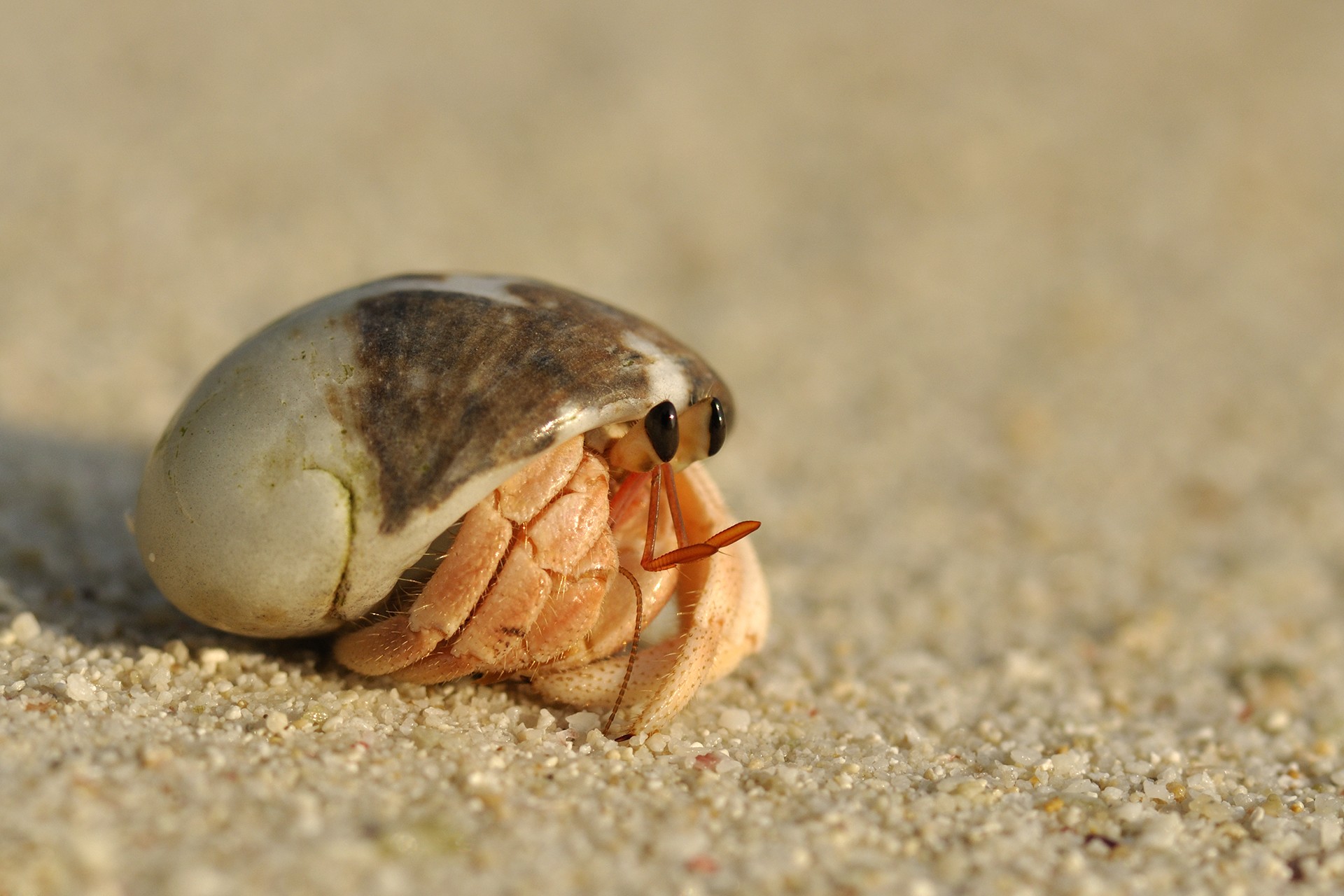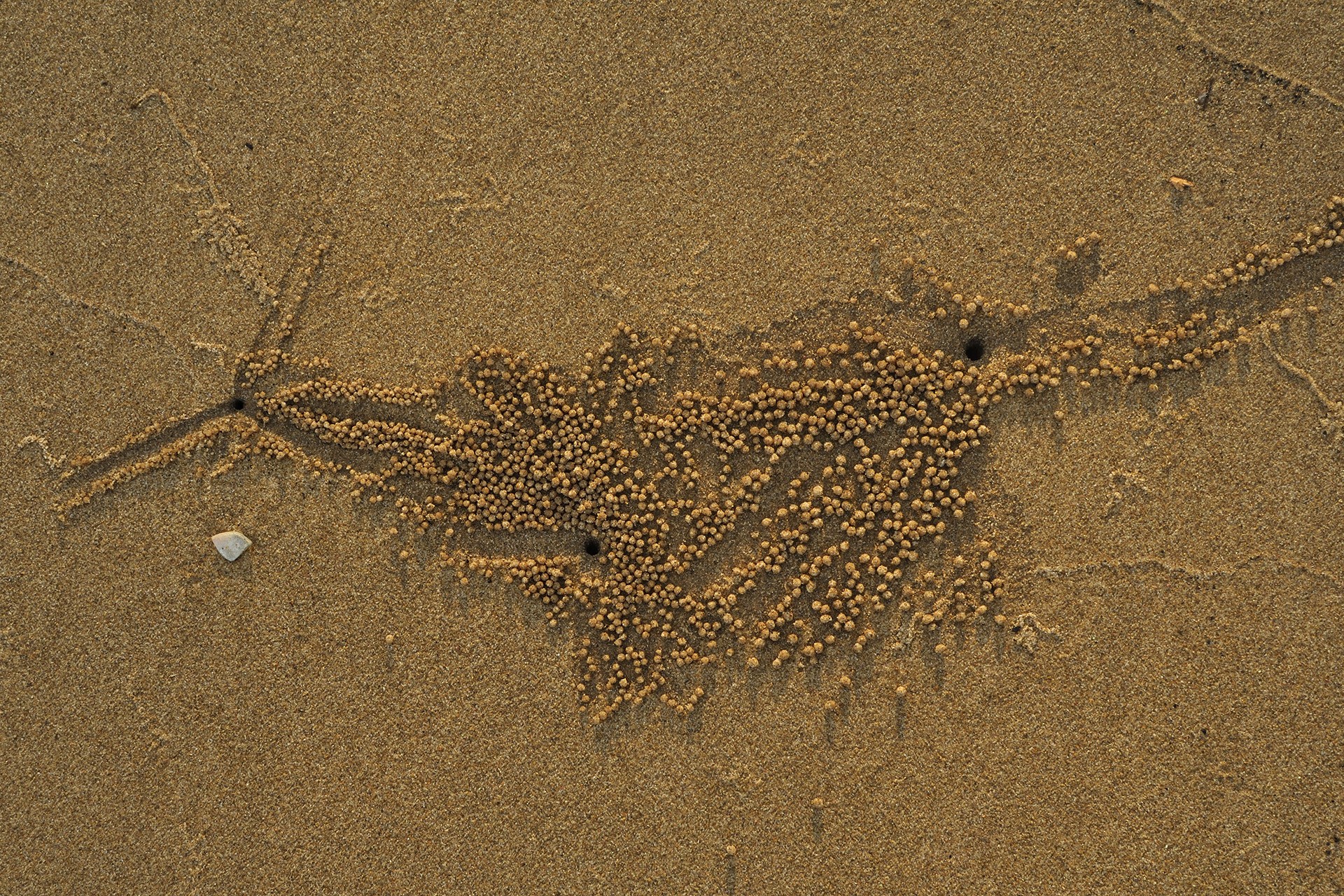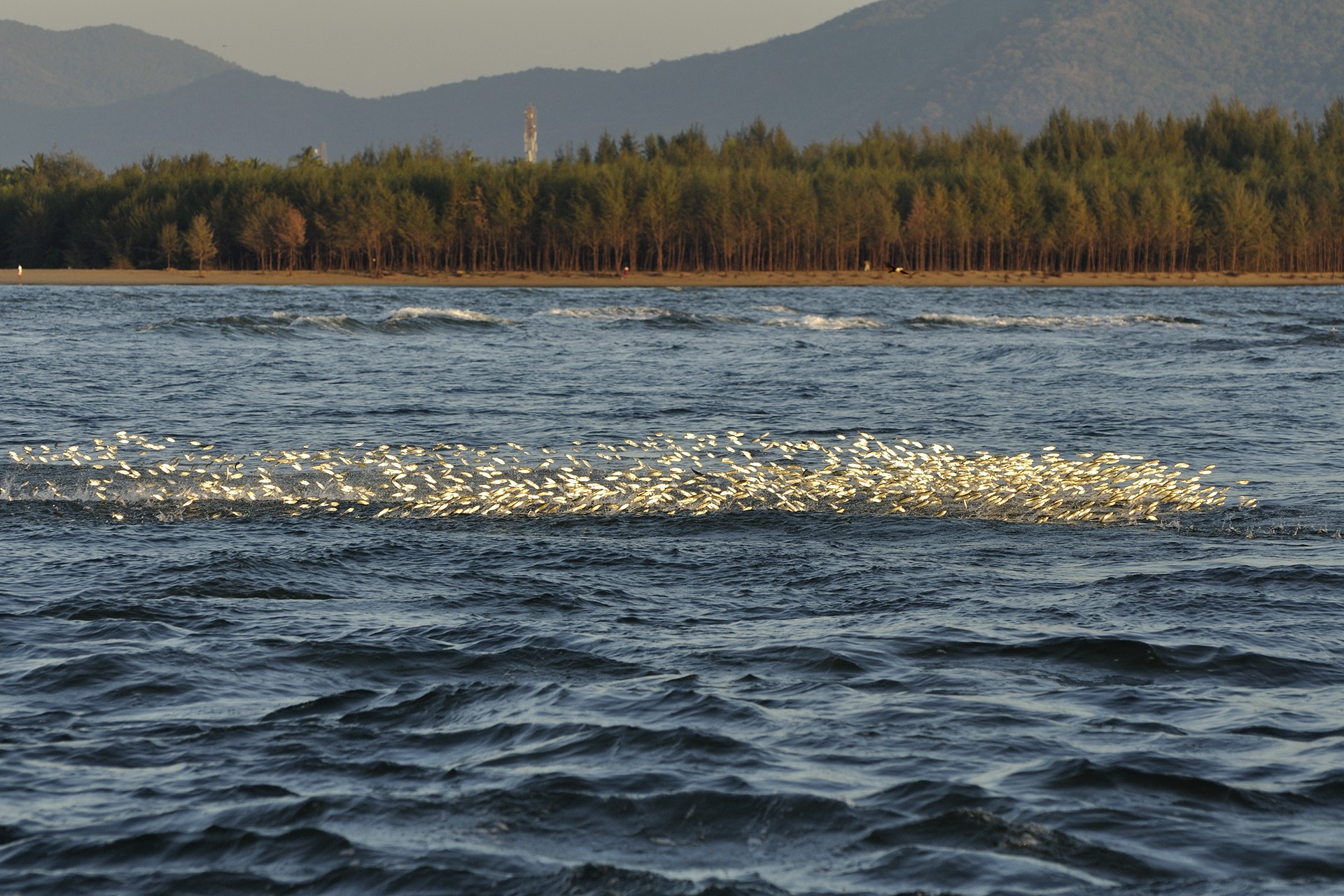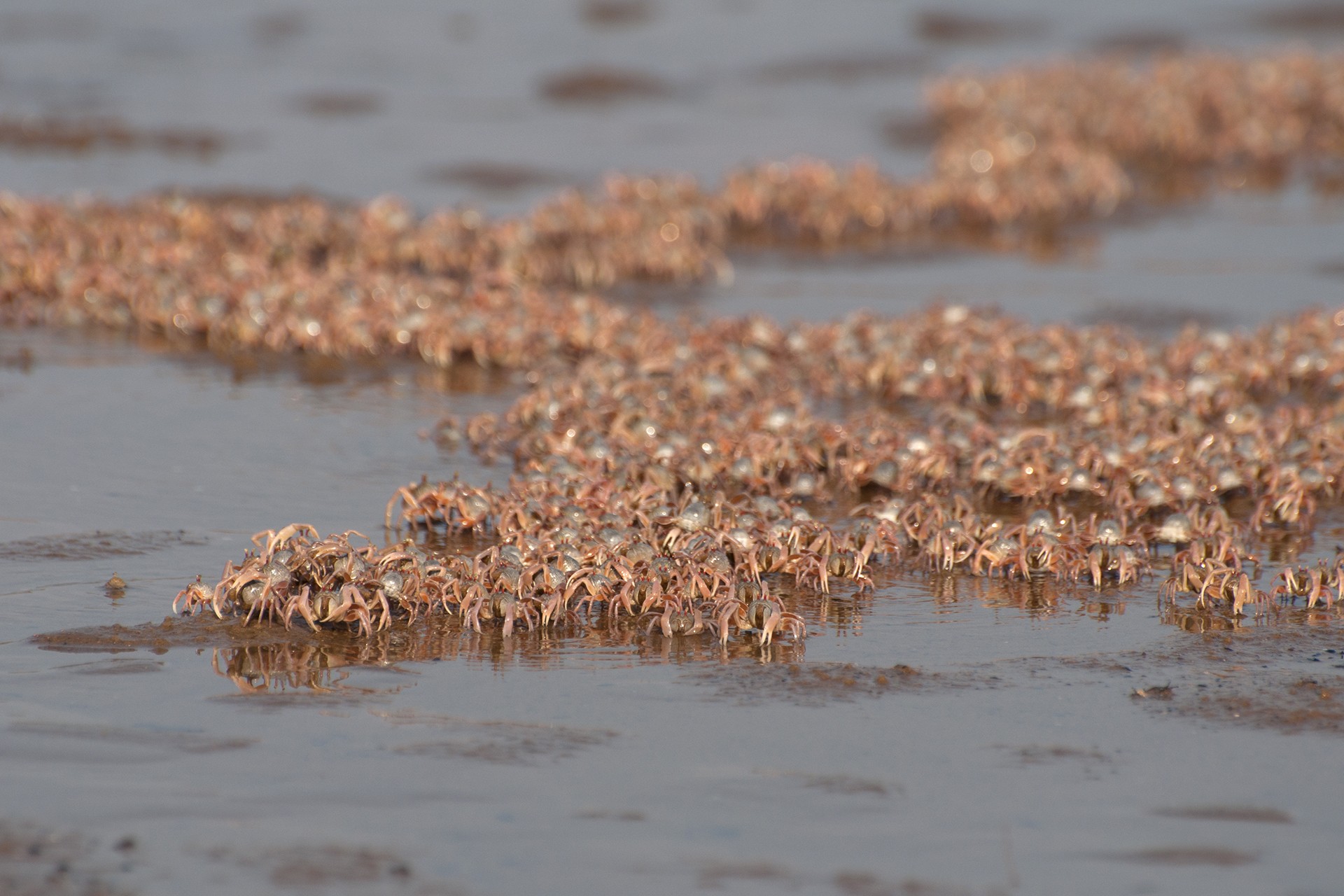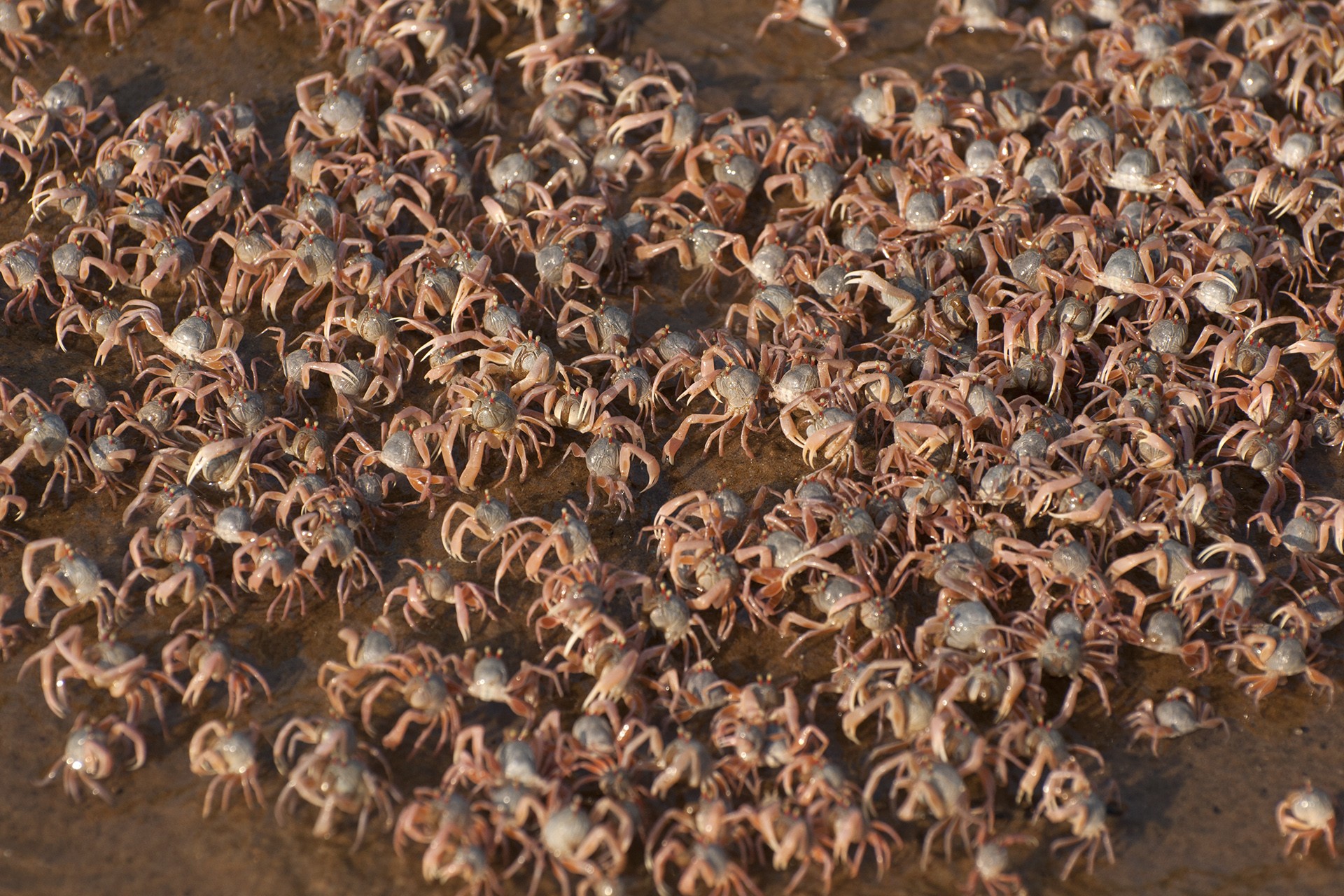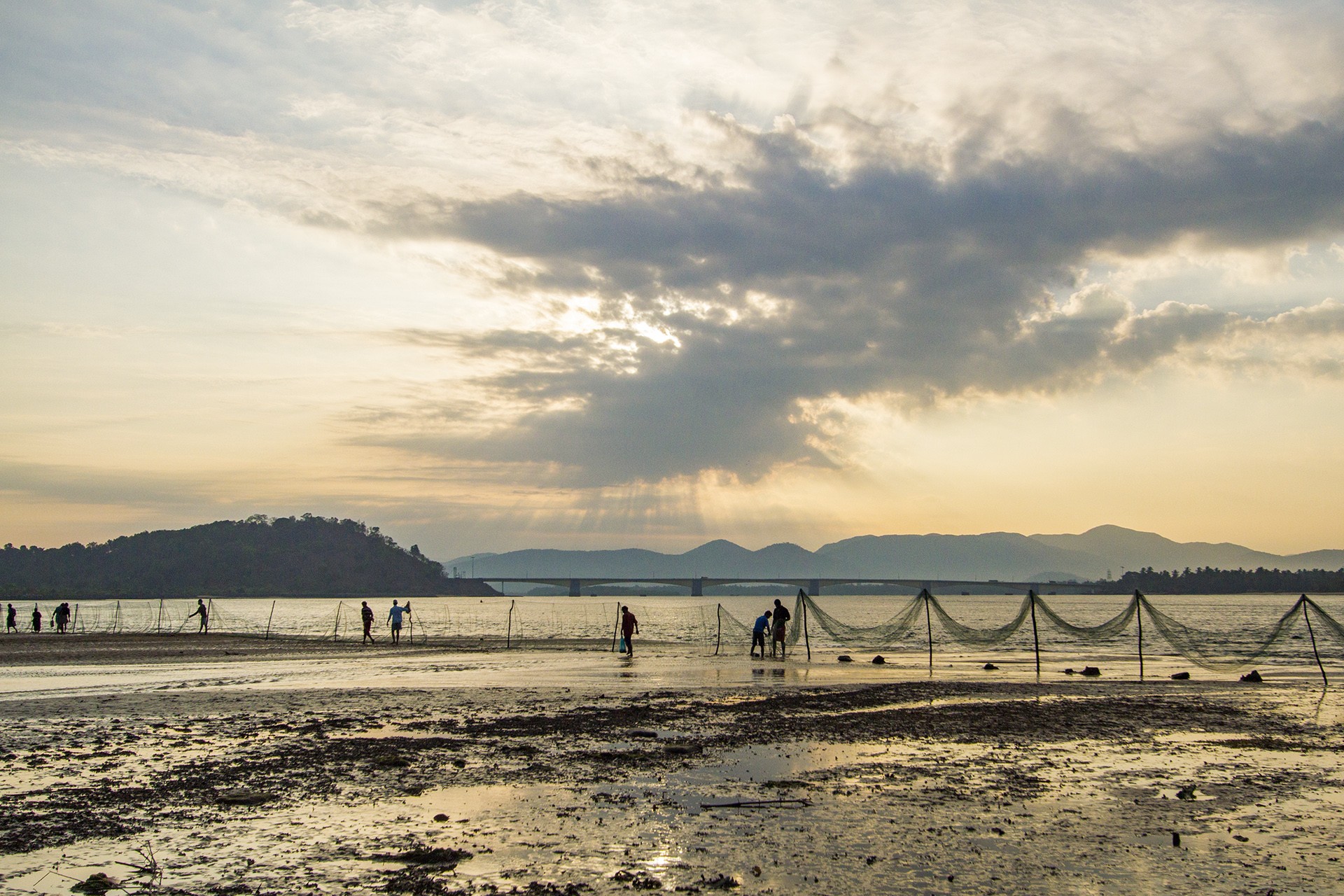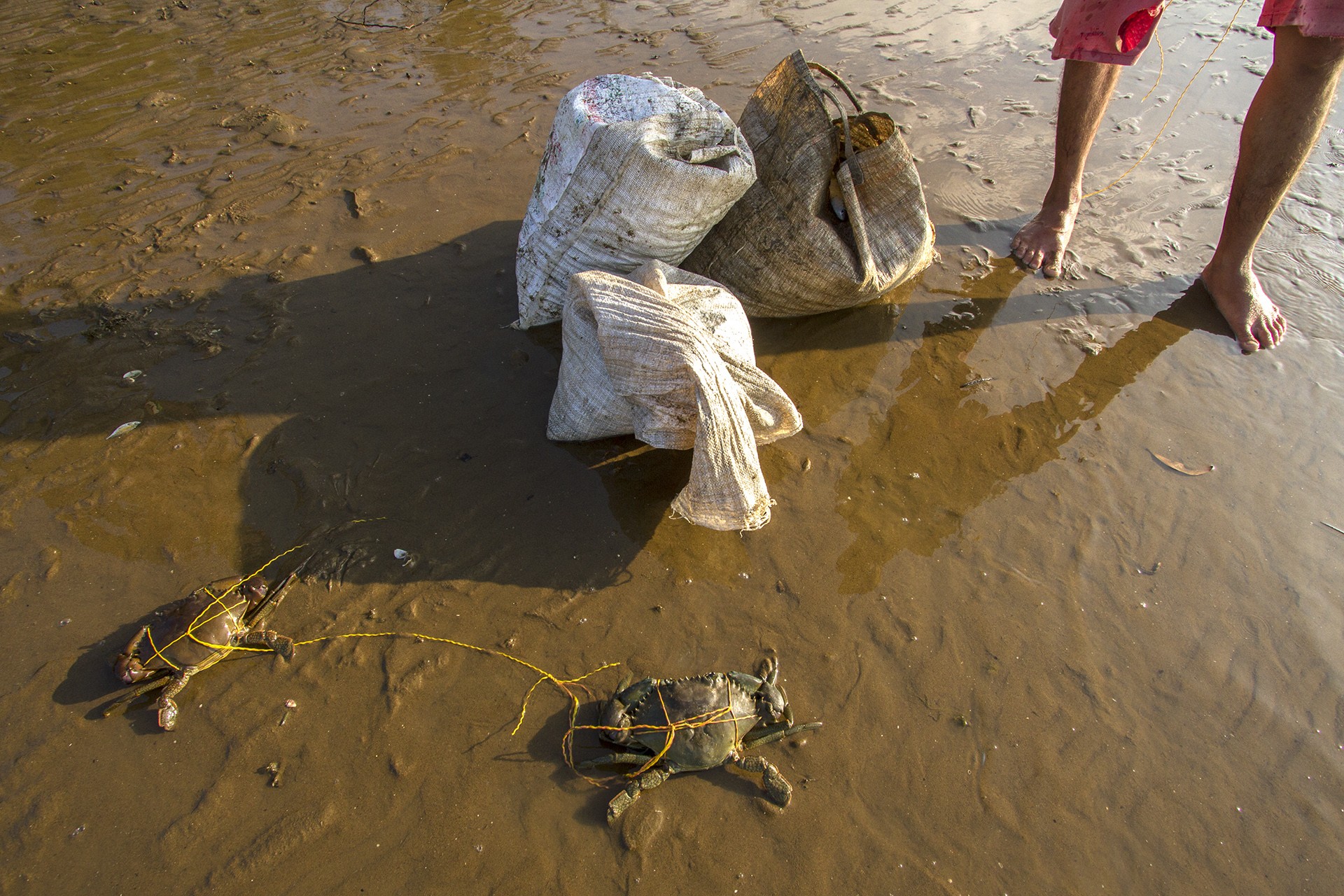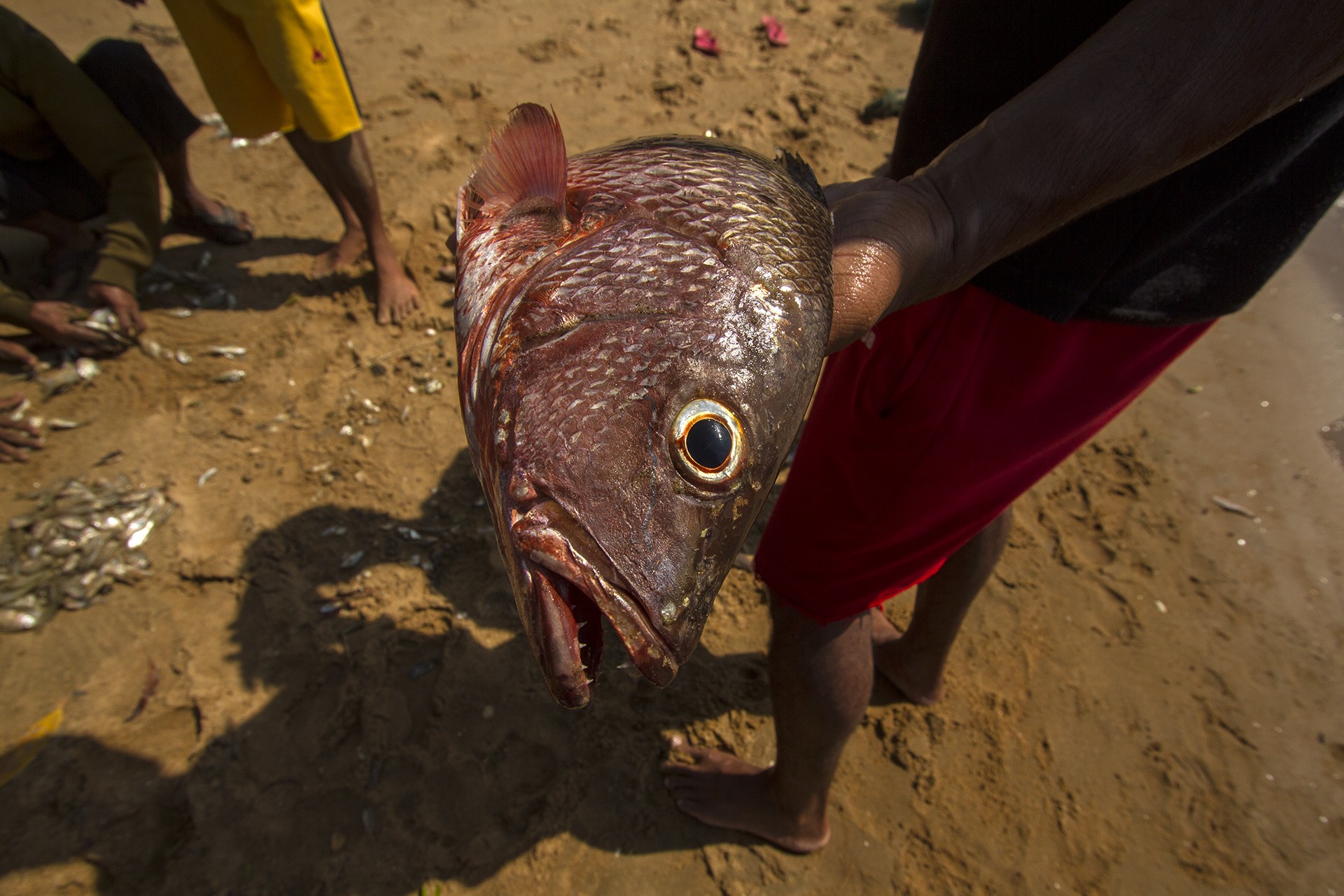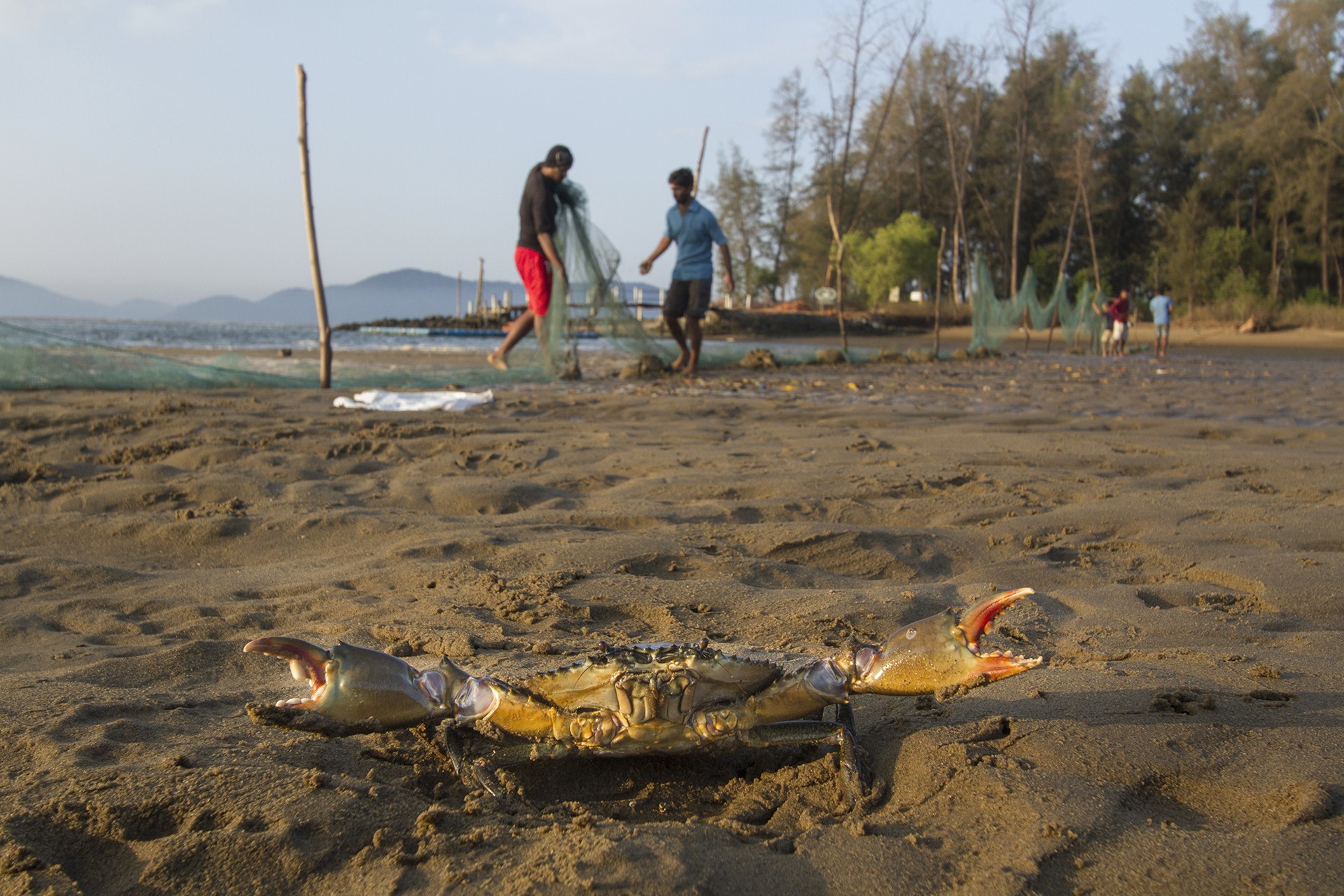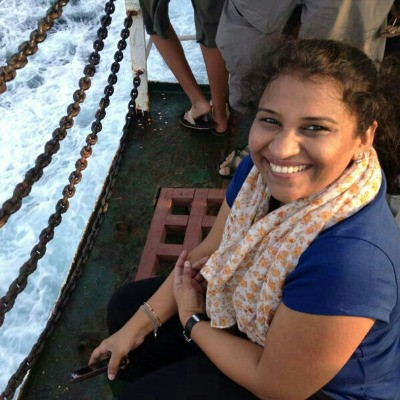The Gooseneck Barnacles were at eye level. From my vantage point — on my stomach in the soft, white sand — I was attempting a shot of them hugging a piece of driftwood, when a movement caught my eye.
To my right, a tiny green shell moved slowly. A few feet away, another moved. I turned left to see two curved legs sticking out of a large orange shell, and then two more shells shifted in the distance; and then some more, further away. Unsettled by a Gulliver-in-Lilliput moment, I sat up, and the shells closest to me stopped moving. As I watched, the front of one shell rose, three pairs of orange legs followed suit, and jet-black eyes on stalks stared back at me. That was all it took. Over the next three days, I pursued these Hermit Crabs all over Neil Island in the Andamans, as they trudged around the beach in their mobile shell-homes (appropriated from other denizens of the sea).
Later that week in February, 2013, while waves on the Radhanagar beach on Havelock Island kept people occupied, little critters far away from the tide line had me enthralled. I watched them for hours, as they picked up balls of sand and put them in their mouths. Using their mandibles, they then added these perfectly round pellets of sand to a hundred others spread out in neat rows from a little burrow in the centre, like an attempt at an intricate design. Their hind legs expertly pushed the pellets away even as their mandibles picked up the next ball of sand. Were they eating? Were the sand pellets waste? Were they decorating? Was it a display pattern on the sand to win a mate? I found the answer two days later on the Internet. These were Sand Bubbler Crabs, and the organic detritus in the sand was their primary source of food. The discarded sand pellets ended up as beach art.
I took my first solo trip to Devbagh Island in Karwar, where River Kali meets the Arabian Sea, on a quest to photograph mangrove forests (on assignment for JLR Explore). Walking along the beach at low tide, I came upon a familiar burrow with sand pellets laid out like beads of a necklace. My eyes followed a couple more, and as I looked further, it was as if the entire beach was covered with them, a giant mural with artists silently at work, rolling up pellets, and laying them out in grids. Memories from that evening at Havelock flooded back like the returning tide, and the deal was sealed. Crabs had firmly made their way into my life.
Windswept and sun-kissed, Devbagh is a treat to the senses. Saltwater from the sea blends with the freshwater in deceptively soft swirls along a rocky edge of the island. The Western Ghats walk into the sea at a distance, and long stretches of white beaches don different garbs each time the tide turns. Receding tides expose large mudflats where White-bellied Sea Eagles and Brahminy Kites land to take a break from swooping down on unsuspecting shoals of fish. The birds, however, keep their distance when fishermen from the village nearby use these sandbanks to dock their canoes while they dive to pick up mollusks and oysters.
A walk at low tide across a sandbank that is otherwise submerged revealed a spectacular phenomenon. The video (below) describes this better than I can ever attempt with words. A sea of pink is what I saw first. Soldier Crabs. Tens of thousands of them; feeding and marching at the same time. I gingerly stepped on the soft sand that had been overturned by them, and almost simultaneously, they all disappeared. I stood still, and a minute later, they cautiously appeared again and began to feed almost instantly. They fed like the Sand Bubbler Crabs - picking up a ball of sand, scouring it for any edible matter and discarding the pellet, but there was no art here; the pellets just lay in lumps around their burrows. Large groups of crabs scurried away as I navigated the sandbank for photographs. Unlike the gentle pat pat my feet made, their escape sounded like the crumpling of soft plastic, courtesy thousands of legs brushing against each other as they fled in panic. A few confused, albeit bold ones gave up running and aggressively held up their claws as high as they could, as a threat display. If they weren’t bright pink and so adorable, it might have even worked on me. Some nonchalant young ones continued to feed through this drama, unperturbed. I never made it to the mangrove patch that noon, simply unable to walk away from them. From a crab-free patch of sand, I watched them — from my now-favourite horizontal position — go about their chores till the tide came in.
I knew then, this needed to be filmed.
I returned to Devbagh the following year with people experienced in filming, editing and photography — Adarsh Raju and Shreeram MV. As someone who, prior to this, only visited the coast on holidays, who has an extreme fear of deep water, and has no formal training in understanding or recognising marine life forms, to me every experience was a first-hand lesson straight from the wild. Apart from one or two scientific papers and a couple of books that had generic information about the species, we had no reference material to rely on. Every moment spent filming was a moment spent learning, and there were so many instances where the behaviour we were watching was previously unrecorded. For instance, we saw Ghost Crabs do a little belly dance while feeding, bending only one eye while the other stood still; Sand Bubbler Crabs jumping in the middle of their feeding routine; larger Soldier Crabs that grabbed little young ones and ran into burrows; Moon Crabs emerging from under the sand, grab a Soldier Crab and disappear again, all in a second or two; Ghost Crabs stalking and grabbing Soldier Crabs. Yet, we never saw any eggs, or any crabs mating. All kinds of birds made a meal of the crabs. White-bellied Sea Eagles routinely picked up large Mud Crabs from the sea. Sandpipers spent all their time on the mudflats around us at low tide, with a few thousand crabs to choose from for their meal. So did herons, curlews, kites, crows, mynas and dogs. A jackal once sprinted past us, but we were so gobsmacked by the sight that none of us took a picture.
It was in Devbagh that I first saw a group of fishermen haul in and sort their catch. With my strong inclination towards species behaviour and natural history, it was not a pleasant experience.
A line net was laid at low tide for about a kilometre across the seabed. The following morning, fishermen from the neighbouring village arrived with bags and baskets and picked up everything that the net had managed to trap on the shallow end. Stingrays, skates, eels, prawns, fish, crabs, seaweed — it was like a marine encyclopaedia on display. Fish struggled in their hands as they were thrown into baskets, where they continued to flop and wriggle. Crabs that tried to get away were tied up with strings. A pregnant stingray was turned upside down, its belly cut up with a pocket knife and its two unborn babies tossed on the seabed. Needlefish, eels and snappers lay in large baskets with their mouths and eyes wide open. I gasped and squealed; sometimes in my head, sometimes aloud. When the fishermen discarded fish they didn’t want, I scrambled to pick them up and put them back in water before they died. I couldn’t sleep that night. And the next.
All the conversations I had with the fishermen kept playing in my head. “There’s hardly any fish left in the sea, our boats return empty.” “The largest fish in this bag only fetches me 100 rupees.” “We cannot afford to send him to school. He comes on the boat with us, to fish.” “My son has gone to the city to find work; he doesn’t want my kind of life.” “This is hard work.” And then there was the old lady who walked around the net looking for discarded fish - she was going to try and sell them, I was told. An increasing awareness of how many beings the sea sustains, how much it puts up with, and how many lives are affected by it brought with it a more balanced sense of opinion. There is a fragile balance (or imbalance?) between keeping the biodiversity of the place intact and the survival of the people who depend on it. If you look at this from either extreme, it's a problem, and there's no rational answer. Yes, they must fish, they must collect from the sea - for their economic survival and for their protein intake - to ensure their wellbeing. But they must take just enough. And for that, we must ask for just enough. The demand for seafood has escalated so much that these fishermen have to go farther and farther out to sea only to come back with meagre catch that doesn’t fetch them much.
Watching the world from the crabs’ eye-level changed my perspectives. The sea was humongous, but so was each wave, and every drop.
